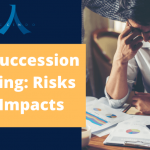
Succession planning is a critical component of business, yet many C-suite executives struggle to create effective plans, leading to disruptions when leaders depart. This blog delves into the importance of comprehensive succession planning, the challenges that arise, and the common mistakes to avoid. By understanding the significance of preparing for leadership changes and implementing effective succession strategies, companies can secure their stability to ensure seamless transitions for sustained organisational productivity.
Introduction
Succession planning is a crucial component of business. Yet many C-suite executives need help creating or completing their plans, leaving companies in a lurch when leaders step down.
Several businesses — including large corporations like Intel and Microsoft — have endured the challenges of their executives leaving suddenly. With a gap between strong leaders at the helm, productivity and organisation falter.
Unforeseen circumstances like these — and even those who depart expectedly — underscore the importance of implementing a comprehensive succession plan. Of course, the planning process itself is often riddled with mistakes. Here’s a breakdown of why preparing for leadership transitions is critical, the most common mistakes in succession planning and how to avoid them.
Why Succession Planning is Important
According to an August 2021 Society of Human Resource Management survey, 56% of companies do not have a succession plan.
The top reasons for not having set protocols were needing more resources, having a small business and operating a family-owned company. However, succession planning is critical for all organisations, regardless of size. Owners should create a plan for the following reasons:
- To withstand an unexpected event, such as an illness or death
- To increase communication between department heads to improve operations
- To provide stability for your teams during transitions
- To save money on hiring and training an external candidate
Glassdoor says external hiring costs nearly $4,000, although expenses vary by position.
For an executive role, companies may need to coordinate several flights for interviews and accommodations.
Why Do Succession Plans Fail?
Each business has unique circumstances to contend with. As such, succession plans are not a one-size-fits-all approach. Some reasons why succession plans fail or poor succession planning include:
- Company executives have difficulty envisioning the future, instead concentrating on outdated management processes
- They forgo a formal document for internal distribution
- Managers are unaware of the skills and expertise required for future roles amid business growth
- Leaders stay with a company longer than expected, disrupting the succession plan timeline
- Leaders avoid prioritising succession planning due to mixed emotions about giving up their positions
- Plans become too complex and challenging to implement
- People approach plans as a one-time process when it must evolve over time
Prioritising a succession plan can save companies from aggravation if someone steps down. However, companies must formally complete their plans for a successful transition.
6 Succession Planning Mistakes and How to Overcome Them
Business owners looking to create a succession plan may feel overwhelmed by the process. Here are six common mistakes people make when succession planning and how to avoid them.
1. Assuming Everyone Wants to Move Up
Executives may have their eyes on one internal employee to take over a leadership role. However, several things can go wrong. What if the potential successor leaves the company or moves into another position in a different department? Assuming talent even has the skills or desire to step into an organisational role is also narrow-minded.
Leaders should broaden their talent pool to give themselves ample options for a successor. Additionally, honing in on non-C-suite employment will ensure enough internal candidates to fill crucial and newly vacant positions as some move up the ladder.
When Samuel J. Palmisano — former CEO of IBM — stepped down in 2012, he appointed the company’s first female chief executive — Ginni Rometty. Rometty’s 40-year career at IBM began in sales and evolved into developing its technology services business.
Upon realising she could no longer keep up with the advancing technology, Rometty selected an internal successor like her predecessor did with her. IBM’s new CEO — Arvind Krishna — started his career with IBM in 1990 as a researcher, eventually becoming senior vice president of its cloud and cognitive software division.
Business owners should also look beyond hiring internally. Although employing someone outside the company is expensive, the best candidate for the role may be out there.
2. Failing to Create an Emergency Plan
While businesses can prepare potential successors through mentorship and skills-based training, companies must have capable individuals who can take over at the last minute. For instance, 73% of employees intended to depart from their current jobs following COVID-19, leaving many essential positions open.
Few business owners create an emergency succession plan to ensure continuity amid abrupt leadership changes. An emergency plan should identify candidates who are the readiest to take over, will demonstrate the utmost leadership potential and are capable of fulfilling ongoing objectives. Selecting a successor with backup candidates is another way to provide stability.
An emergency succession plan came into play in July 2023 when CEO Steve Andrews abruptly stepped down from his role at Briggs & Stratton. Citing personal reasons, Andrews was replaced with interim CEO Kristina Cerniglia.
Cerniglia is Briggs & Stratton’s senior vice president and chief financial officer, joining the company in 2022 after eight years at Hillenbrand, Inc. She also spent 23 years at leading financial institutions, including Stanley Black & Decker. Renowned for her transformational leadership and growth, Cerniglia was prepared for the changes.
3. Avoiding Workplace Advancements
The workplace has changed drastically over the last couple of years. Despite numerous executives calling for in-office work, approximately 50% still work from home or a hybrid week. Likewise, the rapid adoption of artificial intelligence tools has enhanced productivity and efficiency.
Business owners must reflect on their role and anticipate the company’s future demands. For example, a viable successor should have a progressive mindset and a clear vision to move the company forward.
How will remote work, AI and other changes impact corporate leaders and the company? A successor must be well-trained and equipped with the necessary skills to meet the way of the future.
For example, after taking over as Amazon’s CEO in 2021, Andy Jassy backtracked on the company’s remote work policy. In February 2023, he released a return-to-office mandate, prompting a petition of 30,000 signatures from disgruntled Amazon employees. Jassy stood his ground, even after 2,000 workers led a walkout over a lack of trust in his leadership.
Study after study has shown productivity is up amid remote and hybrid work schedules. Businesses fixated on return-to-office initiatives — a sign they’re not with the changing times — are being met with employee resentment, “quiet quitting,” and hiring and retention problems.
4. Developing a Complex Plan
Leaders sometimes fixate on delivering multiple hoops and hurdles for succession candidates to jump through. While candidates must display exemplary leadership and organisation skills, current leaders must balance vetting and avoiding dissuading interest in the role.
A complicated process is also a surefire way to end up with an unfinished plan. The more complex the successor plan is, the more a company risks being unprepared for change.
Consulting firm McKinsey has found a way around this. Senior partners elect a colleague every three years to lead their global management partner. McKinsey conducts the election with an independent third party to ensure fairness.
The straightforward process allows McKinsey’s teams to recognise the fittest internal candidates. As of 2021, Bob Sternfals has assumed the three-year position following a tumultuous tenure by Kevin Sneader — the only elected leader to serve one term within the last five elections.
5. Overlooking Diversity and Inclusion
Diversity, equality and inclusion (DEI) in the workplace are top priorities among employees. In particular, the science and technology fields only employ 9% and 8% of Black and Hispanic workers. Meanwhile, 52% of millennials and Gen Z are unhappy with their workplace’s lack of DEI progress, prompting them to leave after two years.
Leaders get wrapped up in finding a clone to carry the torch. Instead, they should promote the roles to diverse candidates. Companies are 25% more profitable with gender-diverse executives and 36% more prosperous with ethnically diverse leadership.
In December 2022, Kate Johnson officially took over Lumen Technologies after former CEO Jeff Storey stepped down. Her primary goal is revamping Lumen’s corporate culture, planning to empower employees through communication skills activities — like Brené Brown’s Dare To Lead program — and creating a workplace where everyone feels comfortable speaking up.
There has also been a more robust customer-centric approach to solving problems. Johnson is eager to streamline exceptional customer service for greater efficiency and growth. Recognising that at least one-third of Lumen’s 29,000 employees may be wary about the company’s cultural shift, Johnson is determined to win them over.
6. Forgetting to Update Plans Regularly
Plans change, sometimes unexpectedly. It is possible to have a candidate in mind only for them to move on or decide they’re not a good fit. Employees may also improve their readiness through ongoing training and professional development.
Revisiting a succession plan quarterly or every six months will help account for changes throughout the company. Executives may realise several other employees are more capable of the successor role than they previously thought.
The Coca-Cola Company demonstrated its successful succession plan when James Quincey took over the CEO role in 2017. Coca-Cola had evolved its senior leadership structure for long-term growth, continuously strategising a plan to ensure the best candidate filled the role.
Restructuring the company’s succession plan paid off, as Quincey has reached many milestones since becoming CEO. In 2023, he garnered applause for his steadfast commitment to creating a sustainable business, including a circular economy through Coca-Cola’s packaging and conserving water.
The Makings of a Solid Succession Plan
Executives have their work cut out for them when creating a successful succession plan. The risks of not having one — workflow disruptions, lost productivity and the time it takes to bring someone new up to speed — are simply too high.
Utilising succession planning software while working with human resource managers and other C-suite employees is ideal for getting the plan off the ground. Some things executives should consider when creating a succession plan include the following:
- Possible business challenges over the next few years
- The most critical roles in the company vulnerable to a loss of knowledge
- The impact each position has on the company and whether a vacancy would hinder growth
- Position profiles and the expectations for each role
- The jobs best suited to move into a successor role temporarily
- Input from managers and non-C-suite employees regarding eligibility for successor positions
- Training and development programs for successors to transition into their new roles efficiently and effectively
Here are the top 5 tools on succession planning for your reference, you may wish to explore. Top 5 succession planning tools
Key Takeaways
There is a viable solution for every blunder executives make during succession planning. Naming a successor is impossible to do overnight, but creating and thinking through succession plans can stabilise the company’s future. Here are the key takeaways from the blog:
- Initiate succession planning at least 5 years before an employee leaves the company or retires, allowing time to assess business needs and train a qualified successor.
- Avoid assuming key employees will naturally take over; consider their career goals and desires before designating successors.
- Factor in financial aspects, including retirement planning, recruitment costs, training expenses, and potential share selling.
- Tailor succession planning to industry specifics, acknowledging unique requirements such as licences or market fluctuations.
Page Contents






